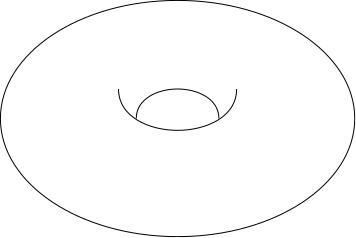A
Maximal tori: Overview
Maximal tori: overview
We now want to understand groups more general than SU(2) and SU(3). One of the key ingredients we used to study those special groups was the weight diagram, which encoded the information about how a representation decomposes under the action of a the diagonal subgroup: T of diagonal matrices e to the i theta, e to the minus i theta inside SU(2) and T of diagonal matrices e to the i theta_1, e to the i theta_2, e to the minus i (theta_1 plus theta_2) inside SU(3).
It's called a torus by analogy: U 1 times U 1 is topologically a 2-dimensional torus (doughnut shape) as a torus has two angular coordinates like U 1 times U 1. Higher dimensional tori are defined to be products of more copies of U(1).

A torus is called
We're focusing on maximal tori because these will give us the most refined decomposition into weight spaces: if you pick a submaximal torus you will always be able to decompose your weight spaces further using the action of the additional U(1)-factors of a bigger, maximal torus. For example, if we'd just used theta_1 in SU(3), we wouldn't have seen the nice 2-dimensional weight diagrams that gave us so much information: we would only have seen projections of these diagrams down to a 1-dimensional line.
Examples of maximal tori
For SU(n), the diagonal subgroup T of diagonal matrices e to the i theta_1 down to e to the i theta_n such that theta_1 plus theta_2 plus dot dot dot plus theta_n equals zero is a maximal torus. This specialises to our earlier examples for n = 2 and 3.
The subgroup T of 3-by-3 matrices cos theta, minus sine theta, 0; sine theta, cos theta, 0; 0, 0, 1 of rotations around the z-axis is a maximal torus in SO(3).
In SO(4), we can find the 2-dimensional maximal torus: T consisting of 4-by-4 matrices with two 2-by-2 blocks on the diagonal: namely cos theta_1, minus sine theta_1, sine theta_1, cos theta_1; and cos theta_2, minus sine theta_2, sine theta_2, cos theta_2; and zeros elsewhere.
In SO(5) we can still only find a 2-dimensional maximal torus: T consisting of 5-by-5 matrices obtained from the SO(4) example by adding a 1 in the bottom right and zeros elsewhere in the fifth row and column. There's no room for another diagonal 2-by-2 block.
This is one of the first points where we see a significant difference between odd-dimensional rotation groups and even-dimensional rotation groups: relative to the dimension of the group, there's a lot more off-diagonal stuff in odd-dimensional rotation groups.
Theorem
Let G be a compact, path-connected matrix group (bounded matrix entries). Then:
-
G contains a nontrivial torus if G is nontrivial.
-
Any element of G is contained in a torus.
-
Any torus is contained in a maximal torus.
-
Any two maximal torus T_1 and T_2 are conjugate, i.e. there exists an element of g such that T_2 equals g T_1 g inverse.
We will not prove (4): the proof would take us too far away from the main themes of the course. The proof uses some very cool ideas from topology, including the Lefschetz fixed point theorem. You can do an in-depth project on this, but it does require a bit of background in topology. We will also not prove (2) fully, though we will make a remark about what we would need for this.
Before we move on to the proof, here are some examples to see why the hypotheses of the theorem are necessary.
Suppose G is the real numbers with addition. Since the real line doesn't contain a topologically embedded circle, there's no way to get a nontrivial torus in G. The real line is path-connected, but not compact, so we see that compactness is necessary.
The assumption of path-connectedness is necessary for part (2) of the theorem. For example, consider G = O(2), the group of orthogonal 2-by-2 matrices. This has two components: the rotations and the reflections. Each component is topologically a circle. The identity component (the subgroup of rotations) is a torus; this the only torus (since any torus is connected and contains the identity) and none of the reflections is contained in it, so the claim that every element of G is contained in a torus fails.
Pre-class exercise
Can you see why the tori we have been using in SU(2) and SU(3) are maximal?